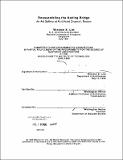Reassembling the rolling bridge : an art gallery at Fort Point Channel, Boston
Author(s)
Lim, Winston E
DownloadFull printable version (31.16Mb)
Alternative title
Art gallery at Fort Point Channel, Boston
Other Contributors
Massachusetts Institute of Technology. Dept. of Architecture.
Advisor
Wellington Reiter.
Terms of use
Metadata
Show full item recordAbstract
Spanning the Fort Point Channel for nearly a century, Boston's Rolling Bridge is a familiar landmark to many railway commuters and residents of the city. Its robust steel assembly, characterized by three anthropomorphic forms, demonstrates the principles of late nineteenth-century bridge design. As a symbol of the industrial age, it is also the last surviving drawbridge of its kind in the city. Unfortunately, this bridge will be demolished as part of the ongoing Central Artery / Third Harbor Tunnel project. Despite numerous efforts to salvage the structure for the arts community in the district, its re-utilization remains doubtful. The bridge's demolition exposes a prevalent problem in the post-industrial city: the annihilation of industrial artifacts by new infrastructural demands. Can one create a new future for an abandoned artifact such as the Rolling Bridge? This thesis suggests that the artifact evolves to dynamically engage its surrounding environment. It proposes that the bridge be dismantled and its parts reassembled into a building. By transplanting the new structure onto an adjacent site, a tension is created between the disappearance of the "ancestor" and the appearance of its "descendant". Recast as an art gallery for the Fort Point Arts Community, the transformed structure will present another chapter of the bridge's history. In re-utilizing the bridge components, the thesis will accomplish two tasks: one, preserve the memory of the original structure; and two, redefine the role of this artifact within the city. The mission is to provoke new ways of thinking about industrial relics by using the bridge as an instigator.
Description
Thesis (M. Arch.)--Massachusetts Institute of Technology, Dept. of Architecture, 1996. Includes bibliographical references (p. 114-115).
Date issued
1996Department
Massachusetts Institute of Technology. Department of ArchitecturePublisher
Massachusetts Institute of Technology
Keywords
Architecture.